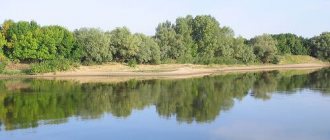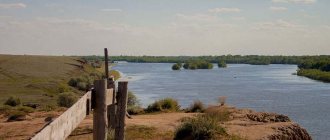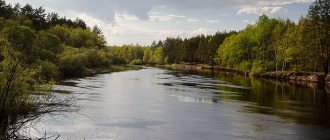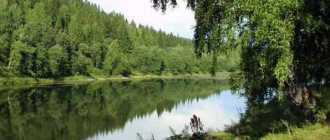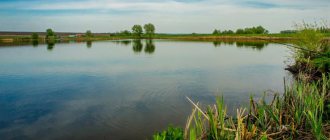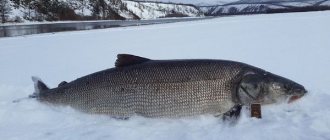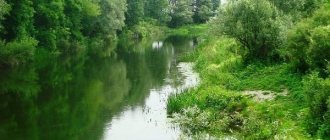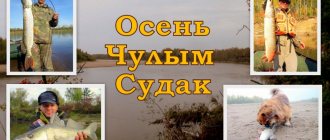The secret to a good catch has been revealed, just pour 1/4 of a slice into the water...
Akhtuba is the left branch of the Volga River, which, together with small channels, rivulets and other bodies of water, makes up the Lower Delta.
The river is characterized by a large width of the channel - in some places it reaches 300 meters, and therefore there is a special expanse for various types of fishing.
Fishing on Akhtuba requires care in choosing places, since each water area has its own characteristics. However, one of the rules is that the further down the river, the more fish there are.
What kind of fish can you catch on the Akhtuba River?
There are more than sixty species of fish in the Akhtuba River, so the water area is often besieged by poachers and industrial fishermen.
Among the small fish species, the most common fish that bite are white bream, silver bream, saberfish and roach. Fans of roach and predatory chub can also count on successful fishing.
Since there are a lot of small fish in the river, large predators - pike, catfish and asp, pike perch - are also hooked.
Representatives of large fish species found on Akhtuba include bream, silver carp, grass carp and carp. Some specimens reach a weight of up to 25 kilograms.
Perch and roach live in reed thickets and under snags, and in places where the current holds the algae in one place, gold and silver crucian carp, ide and bleak often hide.
By the way, pike perch is already considered a trophy if it reaches a weight of 2-6 kilograms, but on Akhtuba there are fish up to 12 kg, which is a great success even for a professional.
Spring fishing on Akhtuba
Spring in the Astrakhan region begins very early. At the beginning of March, areas of open water appear on Akhtuba, and by the 20th the river is completely free of ice. It has been noticed that the predator’s bite is more intense if the ice melts late.
March weather is unstable: temperatures range from -3°C in the morning to +18°C at noon. At the same time, in the middle of the day a cloud may fly in and cover you with wet snow.
The fish bite depends to a large extent on the temperature and water level, which, in turn, is influenced by the operation of the Volgograd hydroelectric station. It is believed that a good bite begins at a water temperature of +6-8°C, but sometimes on a fine day an active predator bite is observed at only +3-4°C.
There is good fishing on Akhtuba in the spring in lakes and eriks, but due to the impassable mud and loose roads at this time of year, getting to them is not easy. The coolest days come from the moment when the floodplain dries up and it becomes possible to get to the lakes by car. At this time, pike bites are especially greedy, literally tearing the spinning rod out of your hands. On the river, the bite of a predator that has recovered from its winter torpor is not spoiled even by a sudden cold snap. But in lakes, windy weather can muddy the water and ruin fishing.
Pike and pike perch become more active after the ice melts. Pike perch stays near wintering pits at a depth of 5-7 m. From the shore they practice jig fishing, from a boat they “jig” in the pits or catch by trolling. In March, pike perch is not very nimble and attacks the bait from a minimum distance from an ambush. It is well caught with live bait, both from a boat and from the shore.
Pike begin their active pre-spawning feeding in March. It is well caught using live bait and artificial baits using a spinning rod (they are selected small in size, since pike in March are not tempted by large prey).
The perch bite only intensifies as the ice melts. It is caught with live bait in small areas, where it is attracted by small fish and insect larvae.
In April, the water quickly warms up, this causes rapid reproduction of the food supply and the activity of hungry peaceful fish. And although restrictions on fishing have been introduced since April 20, this fishing period is the most impressive.
White fish bite well: bream, roach, bluefish and silver bream. In warm shallow waters, rudd is caught, moving in the evening to the lower warm layers; in the algae thickets, silver carp and tench are caught. The following gear is used: wire and Bolognese fishing rods, donka, feeder, and as bait - worms, bloodworms, maggots, shell meat, insect larvae. There are carp, crucian carp and buffalo.
Since mid-April, giant Akhtuba catfish have been caught in deep-water channel pits. It goes for any bait and lure. But the gear must be appropriate. To fish out a giant weighing half a centner, you will have to work hard.
Most fish species spawn in May, and fishing in spawning areas and channels is prohibited. However, you can fish from the shore at some bases. You should focus on catching peaceful fish for which the spawning period has not yet begun: silver and gold crucian carp, bream, silver carp, buffalo, rudd, etc. A worm, maggot, and shell are used as bait. The predator's bite from the shore using live bait or spinning rods is not as intense as in April, but quite impressive.
Fishing tackle and equipment
For trophy and regular fishing, spinning rods with a rod length of up to 2.7 meters and a dough weight of up to fifty grams are suitable.
If the goal is to catch catfish or other deep-sea fish, then a large wobbler and a larger amount of dough are used.
The choice of reels must be approached selectively - you need both multiplier and inertial ones. The latter type is more suitable for fly fishing and vertical fishing.
Braid and fishing line are also needed for trolling and jig-spinning. The bottom equipment is a spinning rod with a spinning reel and a monofilament fishing line.
Groundbaits and bait
There are two types of bait - homemade and store-bought. The classic homemade bait is porridge with the addition of aromatic sunflower oil. The groats are taken from pearl barley and millet in a ratio of 2: 1. The mixture must be cooked correctly - the porridge should not fall apart and so that the fish can knead it. It is recommended to add oil to the almost finished mixture. This bait is often used as bait. The pearl barley grain is placed on a hook so that a curved caterpillar is formed. In the waters of the Volga-Akhtuba floodplain, carp, catfish, goblin, etc. are well caught with such bait.
If time permits, prepare peas as bait. We rinse it well, fill it with cold water for a day (there should be 6 centimeters more water). Then drain the water and grind the swollen peas using a blender. Add semolina (for 500 grams of peas, take 100 grams of semolina), a teaspoon of turmeric and the same amount of sugar. The result should be a mass similar to plasticine. The viscosity is adjusted by adding semolina. Roll the balls. There are many options for preparing homemade bait.
You can also add store-bought flavors to any homemade mixture. The main thing is to follow the manufacturer's recommendations. Don’t overdo it in pursuit of an active bite. In the store you can buy ready-made baits. Basically, they are diluted with water. Experienced fishermen recommend adding water from the reservoir where you will be fishing.
It is better to use bait of animal origin: worms, bloodworms, small fish, meat, larvae and their insects. To get a good bite, add some part of the bait to the purely vegetable bait.
Catching baits and lures
To get a good bite, it is advisable to take care of high-quality bait for many days. Effective products for this are:
- porridge;
- flax bran;
- flavorings;
- cake;
- finely chopped earthworm;
- corn kernels;
- oats pre-steamed in boiling water;
- bread;
- bloodworm;
- ox blood;
- beetles;
- cockroaches.
Complementary foods are chosen depending on the desired type of fish. Predators need animal baits, and peaceful fish need vegetable baits. The following are used as nozzles:
- dough;
- split pea grains;
- boilies;
- corn;
- maggot;
- poultry meat;
- crayfish;
- frog;
- live bait;
- twisters;
- May beetle larvae;
- worm;
- maggot;
- pearl barley.
Winter fishing on Akhtuba
Fishing on Akhtuba in winter begins when the first ice appears on the ilmens and backwaters. On the open river, before frost hits, fishing with a spinning rod, or less often with a feeder, is very popular. As soon as there is ice, the predator begins to be caught using spoons, jigs and balance beams. For fishing on zherlitsa, prepare live bait in advance. Peaceful fish and small perch bite on all kinds of jigs.
In areas with a current, in the edges and drops of the river bed, pike perch and bersh are caught well with balance beams and winter vertical spoons. This fish is not attached to a place and you still have to look for it.
Fishing on the last ice begins in February. Closer to the bays, channels and eriks of Akhtuba, whitefish are actively caught. Fans of predatory fish continue to catch pike perch, bass, perch and pike.
As you can see, fishing on Akhtuba is a continuous fishing holiday for lovers of all fishing methods, from float rods to bottom tackle and spinning rods. We wish those who come to fish on Akhtuba good weather and excellent trophies.
Fishing in Kharabali
One of the most amazing and beautiful places in the Lower Volga is Kharabali. This area is in the vicinity of the city of Kharabali in the Astrakhan region,

replete with rivers, canals, eriks and ilmens, it has long attracted the attention of many professionals and fishing enthusiasts, as well as simply fans of outdoor activities, as well as hunting enthusiasts.
But even among these beautiful places there is its own unique pearl - Three Rivers. This is the confluence of the Akhtuba River and its branches, Mangut and Kharabalyk, which form Rassvet Island. Endless channels and eriks, floodplain meadows and flooded lakes surrounded by coastal vegetation have created a unique natural landscape and a special microclimate here, and the river waters of the Volga and its tributaries bring here abundant food for aquatic inhabitants. In these places there is an abundance of fish (more than 60 species), hundreds of species of water and steppe birds (local and migratory), and many animals. The flora of Kharabali is also unique, both aquatic and terrestrial - thousands of species of plants, shrubs and trees, many of which are endemic, that is, they grow only here.
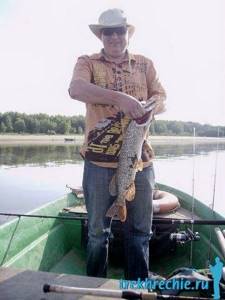
For most species of freshwater fish living in the Volga and the estuary zone of the Caspian Sea, the reservoirs of Three Rivers near Kharabali are a real cradle. Here in the spring-summer period its spawning and the growth of fry take place. Here, juvenile fish of all stripes grow in size and weight - from the most peaceful roaches to such giant predators as catfish. And newly arrived adult predatory and peaceful fish flock here all year round, attracted by the rich food supply. Kharabali attracts fishermen, first of all, with the opportunity to try their hand at catching the “Big Five”: catfish, pike perch, pike, asp, carp.
So, if catfish in the Lower Volga have long been famous for their size, then the Akhtubinsky catfish in Trekhrechye grow to maximum dimensions and such large specimens are caught here, near Kharabali, more often than in other places of the Volga, especially in mid-summer and early autumn, when the catfish is hunting most active. Catfish on Akhtuba reach a weight of more than 100 kg, and individuals weighing 50-80 kg are caught regularly. The large catfish is an inhabitant of the depths; it makes its lairs at the bottom of large channel holes at depths from 6 to 25 meters. Several methods are used to catch catfish:
— catching catfish with a quok from a boat using meat bait or live bait (fish, frog, bird);
- trolling or “lane fishing” with artificial bait;
— catching catfish on a donk with bait (crayfish, crawling worm, fish, frog).
The largest catfish are often caught by trolling, since this method can fish large sections of the riverbed at maximum depths. The fight against a large catfish can last up to 2-3 hours and is more reminiscent of hunting a large animal. This process requires considerable skill and courage from the fisherman in the truest sense of the word.
Another inhabitant of the Kharabala rivers, the possibility of catching which attracts many avid and novice fishermen here, is the large Akhtuba pike perch . A cautious and strong predator, which also has delicious meat, pike perch can be caught almost all year round, but most often large specimens, weighing about 10 kg, are caught in early spring and late autumn. They catch pike perch from a boat, less often from the shore, at depths of 5-6 meters. There are several ways to catch pike perch:
— catching pike perch from the shore with a donka or a live fishing rod with live bait;
— fishing from a boat using a spinning rod using lures;
- trolling with wobblers or jig heads.
The last method, trolling, is the most effective, since pike perch prefers greater depths in open areas of the channel with a strong current, but you need to take into account that it is better to catch it with jig in early spring and late autumn, when it gathers at the bottom at the exits of channel holes, in which spends the winter.

Artificial baits and live baits for catching pike perch should be selected small in size and elongated in shape, since this predator has a rather small mouth. Its favorite prey is whitebait and juveniles of peaceful fish, as well as small whitefish: bleak, verkhovka, gudgeon, roach. In addition, the bait, although small in size, must be heavy enough to “pierce” a large thickness of water in the current. These are, as a rule, deep-sea wobblers, Castmaster-type spinners, jig heads and weighted tackle for live bait.
the carp can be called the “King of Kharabals” among peaceful fish . This beautiful, strong fish reaches a weight of 12 kg or more in these places. Carp weighing 8-10 kg are regularly caught on Akhtuba. Many fans of hunting this fish, the so-called “carp”, strive to go fishing in these regions, since there are really a lot of carp on Akhtuba and, in particular, in Trekhrechye. This is facilitated by a huge number of reservoirs with vegetation and a silty-clay bottom, a warm climate and an abundance of food. Fishing for carp is a painstaking process and requires patience, experience and composure from the angler. It is not easy to catch a large carp - he is very careful, but to take him out and raise him is an equally complex and intense process. And if measured schooling carp weighing 1-2 kg are frequent guests in the cages of even novice amateur fishermen, then trophy specimens weighing 8-10 kg, with such difficulty and all sorts of tricks lured onto a hook by a professional carp fisherman, often leave him only scraps as a souvenir tackle.
The fact is that for catching carp, as a rule, donks or feeders with rather thin leashes are used (otherwise this cautious fish simply will not take the bait), and when fishing, a large carp is tireless, resists desperately, makes unpredictable jerks and tries to go into the underwater thickets plants or snag.
The main methods of catching carp in Kharabali (used both day and night):
— Fishing from the shore with bottom tackle (tackle, feeder, elastic band) with plant and animal baits;
— Fishing from the shore or from a boat with a float rod with a blind or sliding rig.
For successful fishing for carp, baits of animal and plant origin are used as bait, and it is also necessary to feed and establish the fishing spot - that is, having decided on the fishing spot, it is necessary to start feeding the fish in advance the day before. Catching carp occurs both day and night, and on a warm, quiet night the chances of catching a really large specimen increase.
Near Kharabalami, sabrefish, rudd, crucian carp, buffalo, perch, tench, and large bream are also well caught. There are cases of catching silver carp and grass carp. And how many interesting stories about fishing can local regulars tell with a fishing rod or spinning rod in their hands... And here you can also catch crayfish - fishing is permitted in accordance with the Fishing Rules.
I would like to add to the above that near Kharabali on Akhtuba there are quite comfortable and convenient fishing bases, where you can choose a house to stay for every taste and budget, rent a boat with a motor and get qualified assistance in choosing fishing gear and fishing spots. One of these bases is the fishing village “Trekhrechye” on Rassvet Island. Having visited Three Rivers once, next time you will no longer painfully choose where to go for thrills, but most likely you will return here for fishing on Akhtuba, like many other guests of this fishing base.
No tail, no scales!
More
Popular fishing bases
Guests who want to spend a long time in this fabulous place, but do not want to live like savages, can stay in one of the following bases:
- The Avalon fishing and hunting base opens its borders to tourists. It is located on the expanses of the Akhtuba River. Here you can spend an active holiday, doing men's favorite activities: hunting and fishing. In addition, you can have a fun and educational time at the base. The staff of the complex offers tourists a fascinating tour of the lotus field. The minimum cost of accommodation per day per person is 3900 rubles.
- At the Alimovsky Reach base, you can take a break from the hustle and bustle that everyone is tired of and immerse yourself in a new, interesting world of fishing. You can catch fresh fish in backwaters, channels and lakes. You can also try your luck by hunting waterfowl. Near the recreation center there is a strong river current, which will allow guests to purchase a large catch. On its territory there is a hotel complex with rooms of various classes. The minimum cost per person per day is 2,500 rubles.
- The fishing and tourist base “Akhtuba” has existed for many years and functions excellently. The organizers offer a whole range of services for fishing and hunting. In addition, entertainment events are concentrated here; guests can visit a karaoke bar, a bathhouse or billiards. On the territory of the base there is a cozy cafe where you can try fresh fish dishes. The minimum cost of accommodation per person for one day is 3100 rubles.
- In the Khaprabalinsky district, on an area of 12 hectares, one of the largest recreation centers is located - “Akhtuba Club”. Tourists can come here and go fishing at any time convenient for them; the complex’s staff accepts guests throughout the year. They offer accommodation in any cottage you like, which can accommodate from 4 people. The minimum cost of living there for one day will be 8,000 rubles.
- The fishing base "Bely Bereg" is located in a village with an unusual name - Tsagan-Aman. It offers clients a range of services for fruitful fishing. Here you can rent a boat, spinning rods and fishing rods. You can stay in cozy houses; the minimum cost for one day per person is 1,250 rubles.
- The fishing base “Usadba Dali” is located 25 kilometers from the city of Kharabali. It is located on the bank of the Akhtuba River between two farms. Here you can catch catfish, carp, pike, pike perch, bream, perch or roach. Hunting for birds and animals is also common in this area. You can rent a cottage located in this complex for an overnight stay. The minimum cost of accommodation per person for one day is 1000 rubles.
- In a secluded corner of the Astrakhan region there is a recreation center “Sandy Coast”, it is located 15 kilometers from the city of Kharabali. A huge number of tourists are constantly observed here, as experienced fishermen believe that the best fishing takes place here. Guests can expect exciting fishing for pike, bream, rudd, catfish and perch. You can stay in a comfortable hotel complex, the cost of living is from 1300 rubles.
- 18 kilometers from the city of Kharabali there is a base with the romantic name “Meeting Place” . Fishing here is especially good; there are several pools and eriks, ilmens, oxbow lakes and lakes. You can catch fish for every taste, even if you don’t have a fishing rod and bait, specialists will select the equipment. The minimum cost of accommodation per person for one day is 1,700 rubles.
- In the vicinity of the Saransky Corner base, there are erika waters and streams. Here you can find a wide variety of fish, such as pike, roach or pike perch. The staff offers boat rentals to make your favorite activity even more fun. You can stay overnight in small houses. The minimum price of accommodation per person for one night will be 1800 rubles.
- Unity, competitive spirit, team games - all this can be obtained by visiting the Captain's Island base. It is located on the territory of the world's largest oasis, the Volga-Akhtuba floodplain. Guests periodically organize competitions here to see who can catch the largest fish. The minimum cost of accommodation for one night per person will be 2000 rubles.
- The Astrakhan region is rich in unique recreation complexes. One of the most popular is "Delta". Here you can get a rich catch, many vivid impressions and new acquaintances. The minimum cost of accommodation per person for one day will be 1,600 rubles.

